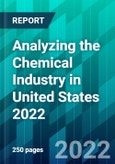Since the start of 2021, the US chemical industry has undergone a strong recovery despite suffering from the COVID-19 pandemic in the previous year. The year 2022 will likely mark a complete recovery for the industry post the pandemic. Though there have been some constraints in the supply chain, despite that, the US chemical industry has been perming well and is further expected to deliver a solid performance in 2022 as well. This industry's advantages include steady demand from numerous end-use sectors, inventory rebuilding, and competitive advantage.
The industry continues to witness strong demand from both specialty and commodity sectors, thus keeping the prices steady and profitable during the year. The sector will likely experience a higher capital expenditure owing to the focus of the leading companies on expansion into growing end markets and building additional capacity. The industry could face the challenge of margin pressures due to the steep hike in raw material costs.
The US Chemical Industry continues to remain one of the world’s largest producer by a substantial margin with a balance of trade surplus in excess of $20 billion. It is a major player contributing 21% in GDP to the US economy.
This report Analyzing the Chemical Industry in United States 2022 is an in-depth analysis of the industry along with its segments. The report provides industry statistics, looks at the impact of COVID-19 on the US chemical industry, market segments, industry globalization, competition in the industry, and many other factors.
The report delves deeper into the processes applied in the US chemical industry and their defining global standards thereby ensuring leadership in exports as well as attracting FDI in the industry. The industry’s dynamics like competition, infrastructure and the regulatory policies with the reporting requirements deployed on the industry are explained by the report. The progress of technology vis-à-vis the environmental costs as incurred by the industry are discussed in view of the energy demands of the industry.
The report defines the industry in two major segments of organic and inorganic sectors and the technologies employed by them. The report also profiles some of the leading players in the industry who have earned the reputation and pride for the US Chemical Industry globally and placing the United States at the top of the pecking order.
Table of Contents
A. Executive Summary
Companies Mentioned
- Bayer AG
- BASF SE
- ConocoPhillips
- Dow Chemical Company
- DuPont
- Eastman Chemical Company
- Exxon Mobil Corporation
- Huntsman Corporation








